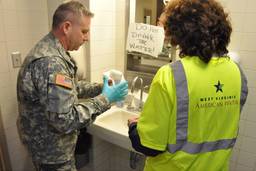Bad Air in ‘Green’ Buildings
Much-touted LEED-certified buildings may not be so perfect.
Melinda Tuhus

As the “green design” economy grows, consumers tend to equate energy-efficient construction with environmentalism. We assume green buildings are in the interest of both the planet and public health. But a recent dust-up between a nonprofit that certifies energy-efficient buildings and a nonprofit concerned about human health has challenged this easy association, raising questions about the costs of going “green.”
A May report from Connecticut-based Environment and Human Health, Inc., titled “LEED Certification: Where Energy Efficiency Collides with Human Health,” raises concerns about indoor air quality in LEED-certified buildings. A certification of the U.S. Green Building Council (USGBC), LEED stands for Leadership in Energy and Environmental Design.
The report notes that LEED certification offers a total of 110 points in seven categories, and that it’s possible to get the top rating – Platinum – while scoring zero points (out of 15) in “indoor environmental quality.”
The seven LEED categories include energy and atmosphere; sustainable sites; indoor environmental quality; materials and resources; water efficiency; innovation in design; and bonus credits. Of the 110 points, 35 are allocated to energy and atmosphere.
The report also raises questions about the quality of water (not just water efficiency), and the presence of pesticides in the building. It states, “There is no legal requirement to inform occupants about the chemicals that have been applied, their potential health effects, or their rate of dissipation.”
The report recommends remedies to these problems, such as putting more health experts on the USGBC board and requiring that builders earn a minimum number of points in each category.
Scot Horst, senior vice president for LEED at USGBC, said EHHI’s objections seemed based on theory. “In practice,” he said, “it’s very hard to earn a Platinum rating without addressing indoor air quality.”
According to the report, as buildings become “greener,” i.e., tighter and more energy-efficient, the danger of trapping pollutants inside increases. The report’s lead author is John Wargo, a professor of risk analysis and environmental policy at Yale’s School of Forestry and Environmental Studies. In an e-mail, he said USGBC certification fails to mandate adequate “ventilation rates.”
“The solution to pollution is not dilution, as the ventilation standards suggest,” Wargo writes. “The true solution is to avoid bringing the hazardous chemicals into the built environment in the first place. “
New Haven has 12 LEED-certified buildings, three of which are Platinum-rated. One of them is 360 State, an upscale apartment building with ground level retail at the edge of downtown scheduled to open later this year. “The [EHHI] report is right on target,” developer Bruce Becker says. “We took indoor air quality very seriously.” He says he spent an additional $100,000 to install wood cabinets and doors that had not been treated with the preservative formaldehyde. “It off-gases and that’s a problem; a green building tends not to breathe as much as traditional buildings. If you have a tight building that doesn’t allow any air movement, it’s poisonous.”
In a June 4 open letter to EHHI, USGBC founder and President S. Richard Fedrizzi wrote, “We could not agree more with the need for serious action on improved indoor air quality. But your report fails to provide a complete picture of how interconnected the built environment and public health truly are.” He then invited EHHI to meet and discuss how the two groups might collaborate.
EHHI accepted the invitation. The meeting will take place on July 22 in one of New Haven’s architectural jewels: the Platinum-LEED-certified Kroon Hall, the new home of Yale’s School of Forestry and Environmental Studies.
Regardless of the outcome, Wargo says he plans to continue working “to assure that green buildings are healthy buildings.”








